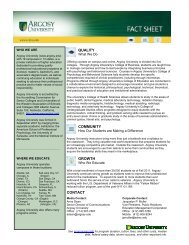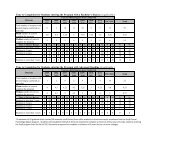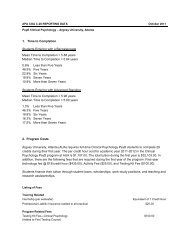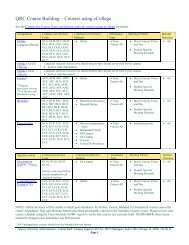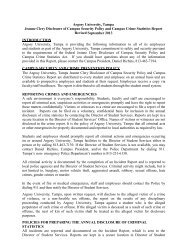Campus Crime and Security Act Report - Argosy University
Campus Crime and Security Act Report - Argosy University
Campus Crime and Security Act Report - Argosy University
Create successful ePaper yourself
Turn your PDF publications into a flip-book with our unique Google optimized e-Paper software.
NATURAL DISASTERSIce <strong>and</strong> SnowIn the event of an ice/snow storm, students <strong>and</strong> employees will be instructed to remain oncampus or at home <strong>and</strong> follow instructions from the CMT regarding campus closure, evacuationor lockdown. The CMT will coordinate with the appropriate parties to ensure the safety ofemployees <strong>and</strong> students.EarthquakeDuring an earthquake, remain calm <strong>and</strong> quickly follow these steps:1. If indoors, seek refuge in a doorway or under a desk or table. Stay away from glasswindows, shelves, <strong>and</strong> heavy equipment.2. If outdoors, move quickly away from buildings, utility poles <strong>and</strong> other structures.3. Caution: Always avoid power or utility lines as they may be energized. Know yourassembly location <strong>and</strong> proceed there as soon as it is safe to do so.4. After the initial shock, evaluate the situation. If emergency help is necessary, callemergency services personnel at 911. Do not panic, but protect yourself at all times <strong>and</strong>be prepared for after-shocks.5. <strong>Report</strong> damaged facilities to security <strong>and</strong> the CMT. If an emergency exists, they willactivate the building alarm to signal evacuation.Note: gas leaks <strong>and</strong> power failures create special hazards.FloodFloods are the most common <strong>and</strong> widespread of all natural disasters--except fire. In floodsituations, the following should be followed:If the flooding is caused by a pipe break, sink overflow or other plumbing problem:1. During normal business hours, notify security <strong>and</strong>/or a member of the CMT.2. Try to identify the source of the water <strong>and</strong> turn it off if this can be done safely.If the flooding is caused by heavy rains or winter snow thaw:1. During normal business hours, notify security <strong>and</strong>/or a member of the CMT.Attempt to close doors <strong>and</strong> windows to prevent additional water from entering thebuilding, if possible.2. Focus resources on minimizing the spread of water to other areas of the building.3. If able:a. Protect property <strong>and</strong> records by removing items from floors <strong>and</strong> /or coveringitems with water-resistant coverings.b. Move items of value to higher ground.c. Unplug electrical equipment such as computers, printers, etc. if it is safe to do so.If electrical circuits appear to be getting wet, leave the area immediately.4. If immediate evacuation is necessary, use the fire alarm system to notify buildingoccupants.TornadoIt is virtually impossible to outrun a tornado; therefore, one should seek shelter whenever atornado warning is issued.The National Weather Service issues severe weather warnings using the following terms:- A “tornado watch” means that tornadoes could develop in the designated area.- A “tornado warning” means that a tornado has actually been sighted in the area or isindicated by radar.- A “severe thunderstorm watch” indicates the possibility of thunderstorms, frequentlightning <strong>and</strong>/or damaging winds, hail, <strong>and</strong> heavy rain.- A “severe thunderstorm warning” means that a severe thunderstorm has actually been42



